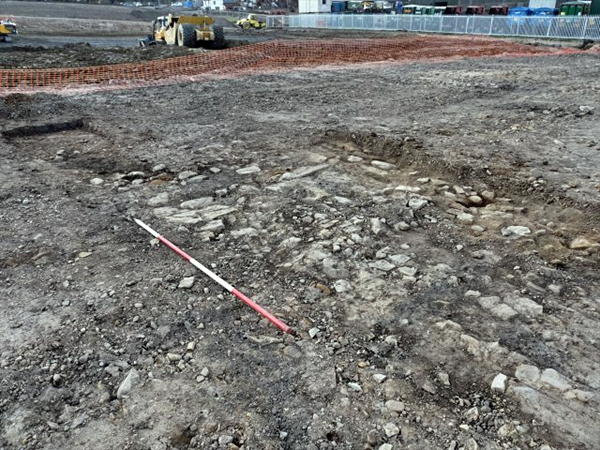
After many years of speculation, the Roman road in Bryn has finally been exposed. Excavations are still in progress but the team of archaeologists from Salford University are hoping to uncover a full fifty metre stretch of it. As reported in last month's Newsletter, evaluation trenches had revealed that the road was lying just below the plough soil and as such, had not survived very well. This was confirmed by these excavations, which show that ploughing over the years has removed most of the upper metalling of the road. Where the metalling has survived it is represented by a layer of fine compacted pebbles. The road's foundation layer, however, has survived and is in the form of large blocks of red and yellow sandstone, showing the road to have been about six metres wide.
This is smaller than expected but matches the section of the road discovered in 1993 on the other side of Bryn Road. The archaeologists intend to cut sections through the road to hopefully expose the side ditches which will confirm its width. The section uncovered so far lies just north of the natural ridge, running across the site which splits the site in two. The southern section is higher than the north by quite a few metres and has a very thin layer of plough soil. Consequently it appears that very little, if any of the road has survived in this area. It also seems that large drainage work at the base of the ridge, probably in Victorian times, has destroyed any evidence of the road here too. It cannot, therefore, be determined how the Romans elevated the road onto the higher ground. However a revetment wall has been discovered supporting the current track as it ramps up the ridge (this track runs parallel to the Roman road just a few metres to the east). The wall consists of large sandstone blocks and it is tempting to imagine that these same blocks could have been used by the Romans to get their road up onto the ridge too.
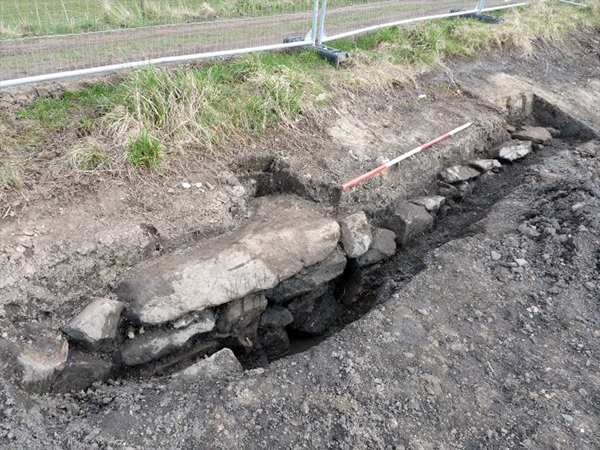 The archaeologists will be continuing for another week or so, to excavate and record the site before the developer moves in. As mentioned before, we have been invited to help so please make contact if you want to get involved.
The archaeologists will be continuing for another week or so, to excavate and record the site before the developer moves in. As mentioned before, we have been invited to help so please make contact if you want to get involved.
St Wilfred's Gaffiti Survey
What a great turn out we had last month for our Historical Graffiti survey of the Parish Church at Standish. As mentioned in last month's Newsletter, this 16th century Grade I listed building had great potential for graffiti. However we were totally surprised at the number of marks discovered. Over a hundred marks have so far been identified - so many that we still haven't recorded them all, even after two visits. They seem to be mainly mason's marks but a detailed study may reveal many of them to be protective markings (these marks are usually located around door entrances and windows, positioned to prevent the evil spirit from entering). On our second visit, we were given access to the spiral staircases of the two internal turrets. This has revealed many more marks. Particularly interesting, however, were the inscriptions on the back of the turret doors which appear to date from the early 17th century (including perhaps our first scorch mark). Detailed analysis of our findings will be carried out by Ellen McInnes and Carolanne King, who are directors of the Greater Manchester Graffiti Survey. We would like to thank Joe Bazeley, Treasurer and Tour Guide of St Wilfrid's Standish for arranging access. Also Joe's indepth knowledge of the building and history was absolutely invaluable. Thanks also to Alan, Jean and Irene Stone for their patience in presiding over the Society work carrying out the survey.
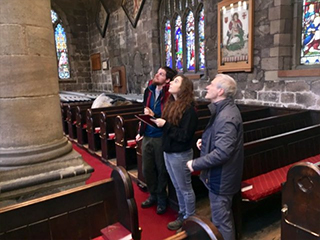
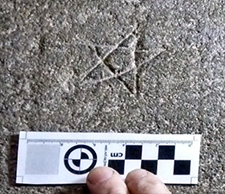 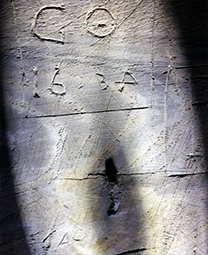
Next Meeting
Wednesday 4th April. - in the Standish Suite at the Brocket Arms (7.30pm as usual). This month we have Judith Atkinson telling us about the construction of the Manchester Ship Canal. It was finished in 1893 linking Manchester with Liverpool 40 miles away. Ocean going ships of up to 8,000 tons were now able to reach the newlyfounded port at Manchester. It eventually became the third busiest in Britain with almost 20,000,000 tons of freight a year carried at its peak in 1958. Judith's talk is entitled Building the Big Ditch which I'm sure will be absolutely fascinating, hope to see you there, BA.
|



